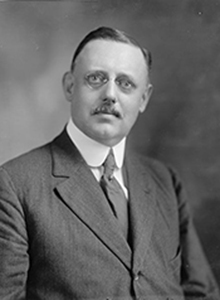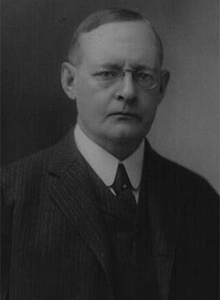
William P.G. Harding
- Governor [President], Federal Reserve Bank of Boston, 1923–1930
- Governor [Chair], Board of Governors, 1916–1922
- Member, Board of Governors, 1914–1916
- Born: May 5, 1864
- Died: April 7, 1930
William P.G. Harding served at the Board of Governors of the Federal Reserve System from August 1914 to August 1922. He also was the third governor at the Federal Reserve Bank of Boston, serving from January 1923 to April 1930.
Harding was born in Boligee, Alabama, in 1864. He received bachelor’s and master’s degrees from the University of Alabama in 1880 and 1881, respectively, making him the youngest full graduate in the history of the university.
Harding began his banking career at J. H. Fitts and Co. in Tuscaloosa and later moved to Birmingham, where he was employed as a bookkeeper at the Berney National Bank and eventually advanced to the position of cashier. He went on to become vice president and then president of the First National Bank of Birmingham. Additionally, before 1913, Harding was a financial adviser to Alabama Congressman Oscar Underwood.
In August 1914, Harding began his service to the Federal Reserve System with his appointment as a member of the newly created Federal Reserve Board of Governors in Washington, DC. In August 1916, he was designated as the second governor (chairman). During this time he was also managing director of the War Finance Corporation from 1918 to 1919. When his term expired in 1922, at the request of the president of Cuba, he traveled to Cuba to advise the Cuban government on reorganizing its financial and accounting system.
Upon his return to the United States in 1923, he was elected president of the Boston Fed. While in that position, he instituted the practice of holding annual meetings with all member banks to foster closer cooperation and better understanding. He also was an advocate of giving member banks a larger share of Reserve Bank earnings through declaration of larger dividends. Harding was considered a key figure during the seminal years of the Federal Reserve System, and in 1925 he wrote a book, The Formative Years of the Federal Reserve System.
Harding died at his home in Boston's Algonquin Club in 1930. He is the only Boston Fed president to die while in office. The grandson of noted American portrait painter, Chester Harding, he had published a monograph on his grandfather’s life and art and was working on a larger biography at the time of his death.
Written by the Board of Governors of the Federal Reserve System. See disclaimer.





